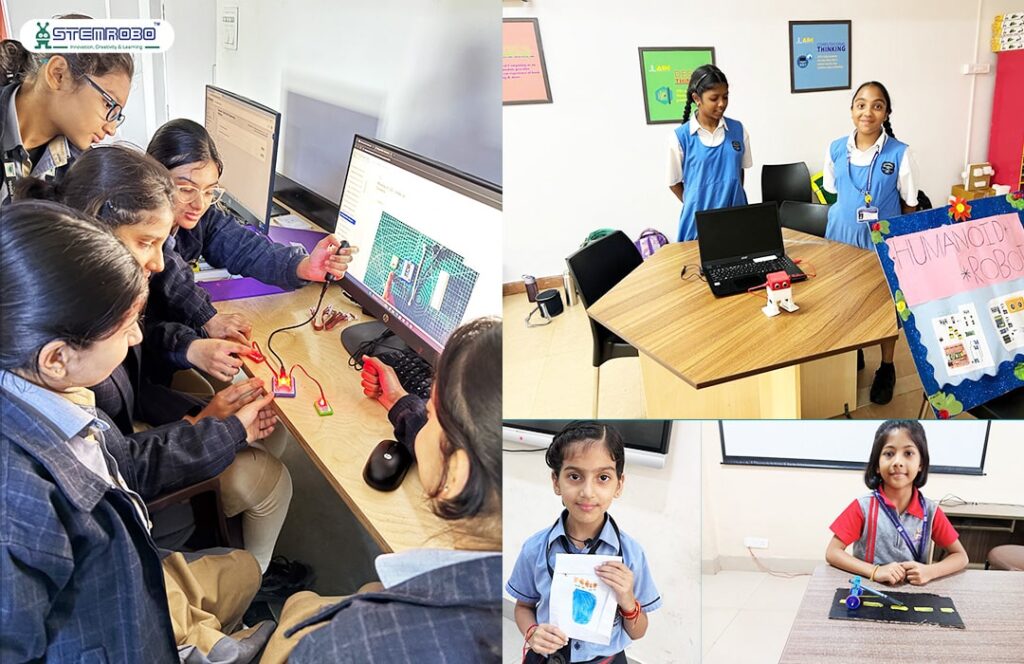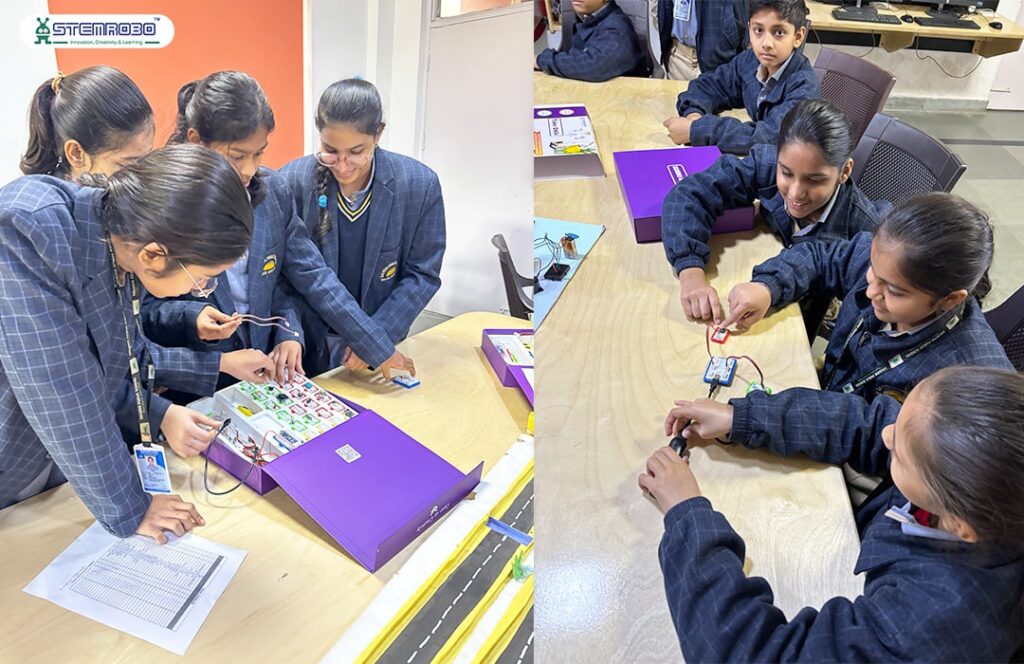Starting early is everything. Imagine a world where every girl steps into a classroom, knowing that STEM isn’t just a “boys-only zone,” but a playground full of endless and exciting possibilities, from AI to biotech and robotics. With the right robotics syllabus for school students and exposure to real-world problem-solving, this can become a reality.
Although the education of women in the world has been raised to a significant level, a substantial gender gap still exists in STEM careers. The UNESCO states that 35% of female graduates are majoring in STEM subjects, representing no change in the number over ten years. However, in real life, their number crashes immediately: only 26% in AI and data science, 15% in engineering, and a mere 12% in cloud computing.
India seems to be an example due to nearly 40% of STEM students being females. However, only 14–27% of them continue in the STEM field. Encouraging women to dream big is only one side of the issue. The most significant part is about building a society open to these dreams enough. That’s where Educational Technology Company like STEMROBO come in, offering innovative ideas for school development to support girls in STEM from an early stage.

Traditional gender roles and patriarchal norms continue to decide who belongs where, often forcing women to choose between career and conformity. Until the ecosystem evolves, especially that of India, true equality in STEM will remain out of reach.
But here’s where the real problem arises: society still decides what’s “acceptable” for women. “Normal” career choices like teaching or nursing are applauded, but when a woman chooses engineering or AI, she’s often questioned or doubted. Flip it around—a man becomes a homemaker or a nurse—and judgment follows him too. These aren’t individual choices anymore; they’re boxed-in expectations built by a patriarchal mindset. Until society stops deciding who belongs where, equality in STEM will stay just a number on paper.
The Stereotype
People often say, “Women have it easy,” “A man can’t afford to be jobless, he’ll be shamed.” – said by a man. But the real question arises: who has set this system up?
“A man should be a breadwinner, a provider.” “A woman should help her in-laws after her marriage.”
Well, deep dive into every stereotype, and you will get the very sure answer — they’re man-made expectations born from a deeply rooted patriarchal system, one that sets the standards, defines the roles, and then turns around to question a gender’s potential after burying it under centuries of bias.
The Leaky Pipeline: Understanding the Dropout
“Leaky Pipeline” means the way women drop out at different stages of the STEM journey, starting strong in classrooms but gradually leaving due to problems like lack of support, mentorship, or exclusive workplaces. It shows how talent is lost before reaching the finish line.
Various factors contribute to this attrition:
• Lack of Gender-Sensitive Career Guidance: Most girls have joined the STEM field without the correct professionals’ help on how to start. With STEMROBO’s AI and IoT learning Solution for schools, students can now explore career pathways with a futuristic perspective.
• Absence of Female Role Models and Mentorship: The small number of women visible in the STEM field makes it difficult for girls to relate or feel motivated. Mentors help teams with a good feeling and open doors for them. Tinker and Innovation Programs for Schools can bridge this gap.
• Cultural and Societal Expectations: Gender stereotypes and family pressures are among the reasons which further lead women not to pursue or stay in STEM careers, especially after marriage or childbirth.
A woman is judged if she prioritizes her career and dreams. Even if she continues her work after marriage or childbirth, she still has to “multitask”; keep the in-laws happy and the list goes on. This is not the same in the case of the man.
• Unwelcoming Work Environments: Prejudices and lack of inclusiveness make professional life uncomfortable; women’s efforts are often doubted or wrongly addressed to men. If a woman makes huge strides in her career, she is often questioned if she is being ethical, or if she even “deserves” an applaud.
Quoting a lyric of the hit song “The Man” by pop star Taylor Swift – “I’d be the man. They’d say I hustled. Put in the work They wouldn’t shake their heads and question how much of this I deserve What I was wearing If I was rude Could all be separated from my good ideas and power moves?”

The Crucial Role of Teachers and Educational Institutions
Teachers’ Attitudes and Support: Educators play a vital role. They are one of the most important segments of a child’s motivation and growth. Even unconscious gender biases can discourage girls from STEM by making them feel unsupported or undervalued in classrooms.
Early Gender-Sensitive Career Guidance:Introducing girls early to diverse STEM careers and breaking stereotypes is crucial. Sharing success stories and involving parents builds a strong support system for the girls. That’s why gender-sensitive career guidance needs to begin early.
Schools should actively nullify the stereotypes by organizing STEM career days, inviting women role models from the tech and science industries to speak, and promoting hands-on workshops where girls can explore their talents fearlessly.
Including parents in this journey is equally important. Coding and AI Platforms providers Company can also contribute by making technology accessible and relatable.
Teachers Matter: When teachers encourage equal participation, use inclusive language, and foster hands-on, collaborative learning, they make STEM engaging and empowering for all girls. Using inclusive language, sharing diverse examples, and ensuring every student has a role in group activities, they help build equity in the classroom. Curriculum for Schools must evolve to reflect these values and initiatives.
21st-century skills for students and teachers teach inclusion and diversity. This teaches the students how to build an inclusive society, and encourages teachers to support every learner—regardless of gender or background—equally.
Conclusion
Despite more girls stepping into STEM classrooms than ever before, too many are still missing from the big stage, the STEM careers where their magic truly shines. It’s like the greatest song never gets to be played.
The truth? We need to change the whole playlist.
At STEMROBO, we believe in empowering girls to be their best selves. We have a vast number of STEM engineers and educators who shine as role models for the school girls they interact with. The relationship between the educator and students becomes a bond of motivation and inspiration.
Girls deserve career guidance that speaks their language — tailored advice that shows them STEM isn’t just equations and wires, but a world of endless possibilities where their passions belong.
They need mentors who’ve walked the path, role models who say, “Hey, I’ve been there, and you can own it too.”
And schools? They should be arenas of encouragement, where stereotypes are the old hits we’ve retired, and inclusion is the new chart-topper. With the support of STEM Education Solution Providers Company like STEMROBO, girls can find their spark at a Stem innovation and learning Centre. ATL Labs in schools ensure there is proper communication and
Educators, organizations, policymakers—this is our call to action. It’s time to rewrite the future’s soundtrack with a chorus that celebrates every girl’s potential to innovate, lead, and shine.
Because when we unlock these women’s talents, we don’t just change careers—we change the world.
So let’s turn the volume up on diversity, turn the page on old stories, and make sure every girl’s STEM dreams get the encore they deserve.

